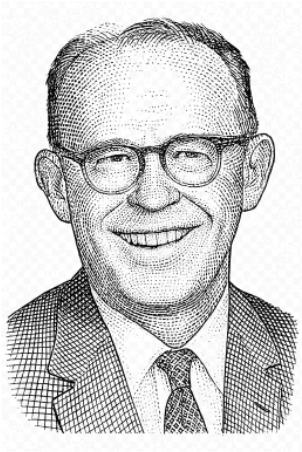Radiocarbon dating is a method of determining the age of carbonaceous materials by measuring the amount of radioactive carbon-14 remaining in them.

Developed by the chemist Willard F. Libby (see above picture) in 1949, radiocarbon dating, also known as carbon-14 dating, is one of the most widely used techniques in archaeology, paleontology and environmental science because it allows scientists to estimate when an organism died. The method is based on the radioactive decay of ¹⁴C, an unstable isotope of carbon that forms naturally in the upper atmosphere.
When cosmic rays strike atmospheric ¹⁴N, a small but fairly constant amount of ¹⁴C is produced:
This radioactive carbon combines with oxygen to form carbon dioxide, which plants absorb through photosynthesis. Animals then consume the plants and incorporate ¹⁴C into their bodies. As long as an organism is alive, it constantly exchanges carbon with the environment, keeping the ratio of stable ¹²C to radioactive ¹⁴C roughly constant.
When an organism dies, however, it stops taking in carbon. From that moment on, the ¹⁴C in its tissues begins to decay at a known rate, transforming back into ¹⁴N through beta decay:
The decay rate is characterised by ¹⁴C’s half-life of 5,730 years. By comparing the amount of ¹⁴C remaining in a dead organism to the amount it would have contained while alive, scientists can determine how long it has been since the organism died.
The fundamental principle behind the method is expressed mathematically using the first-order radioactive decay equation:
where
is the amount of radioactive carbon remaining after time
.
is the original amount at the time of death.
is the decay constant, and is related to the half-life
of the decaying species by
.
is the time that has passed since death.
To illustrate how radiocarbon dating calculations work, consider the example of an archaeological team that discovers a wooden tool handle at an ancient settlement. The ratios of ¹⁴C to ¹²C in a sample of the tool and in modern wood of the same type are analysed using mass spectrometry to be and
respectively.
Because all living organisms share essentially the same carbon isotopic composition as the contemporary atmosphere, any decrease in ¹⁴C relative to ¹²C reflects radioactive decay occurring after death. Assuming that the concentration of the stable isotope ¹²C is the same in the sample and in modern wood, the fraction of radiocarbon remaining in the sample is:
Combining the radioactive decay equation with the half-life equation gives:
Substituting eq70 and ¹⁴C’s half-life of 5,730 years into eq71 yields years, which is the uncalibrated radiocarbon age of the wooden tool.
Although the raw radiocarbon age can be calculated precisely, it does not necessarily correspond directly to calendar years. The amount of ¹⁴C in the atmosphere has not been constant over time; it has fluctuated with solar activity, geomagnetic field strength, ocean circulation changes, and most recently human activities such as fossil fuel burning and atmospheric nuclear tests. To correct for these variations, radiocarbon ages must be calibrated using independent chronological records, most importantly tree-ring sequences (dendrochronology). Calibration curves allow raw radiocarbon ages to be converted into more accurate calendar ages.
Finally, radiocarbon dating is reliable for materials up to about 50,000–60,000 years old. Beyond that point, so little ¹⁴C remains that it becomes difficult to distinguish from background radiation and measurement noise. Despite these complications, radiocarbon dating remains extraordinarily valuable. It has been used to date archaeological sites, reconstruct past climates, verify the authenticity of historical artifacts, and study ecological changes. For instance, it helped determine the age of the Dead Sea Scrolls, revealed the timing of glacial advances and retreats, and allowed scientists to track how ancient cultures expanded or declined.